Meet VanKast AI
Creador de IA definitivo
Article GeneratorContent ImproverBlog ContentsAd CreationsText to SpeechAnd Many More!
Una plataforma para generar todos los contenidos de IA y locuciones de IA





Comienza a escribir en 3 pasos fáciles
How does it work?
1
Paso 1
Selecciona una herramienta de escritura
Elige entre una amplia gama de herramientas de IA para escribir anuncios de redes sociales, secciones principales, publicaciones de blog, ensayos, etc...
2
Paso 2
Dinos sobre qué escribir
Explica con tantos detalles como sea posible a la IA sobre qué te gustaría escribir.
3
Paso 3
Generar contenido de IA
Nuestra IA altamente entrenada entiende tus detalles y genera contenido único y humano en segundos.
Descubre las herramientas de IA disponibles
The Ultimate Power of AI
Bots de chat de IA
Asistentes virtuales de IA creativos
Hemos entrenado a nuestros bots de chat de IA con el conocimiento de expertos de la industria y expertos en conversión para que puedas estar seguro de que sabe cómo hacer su trabajo y responder todas tus preguntas al instante y proporcionar la información solicitada
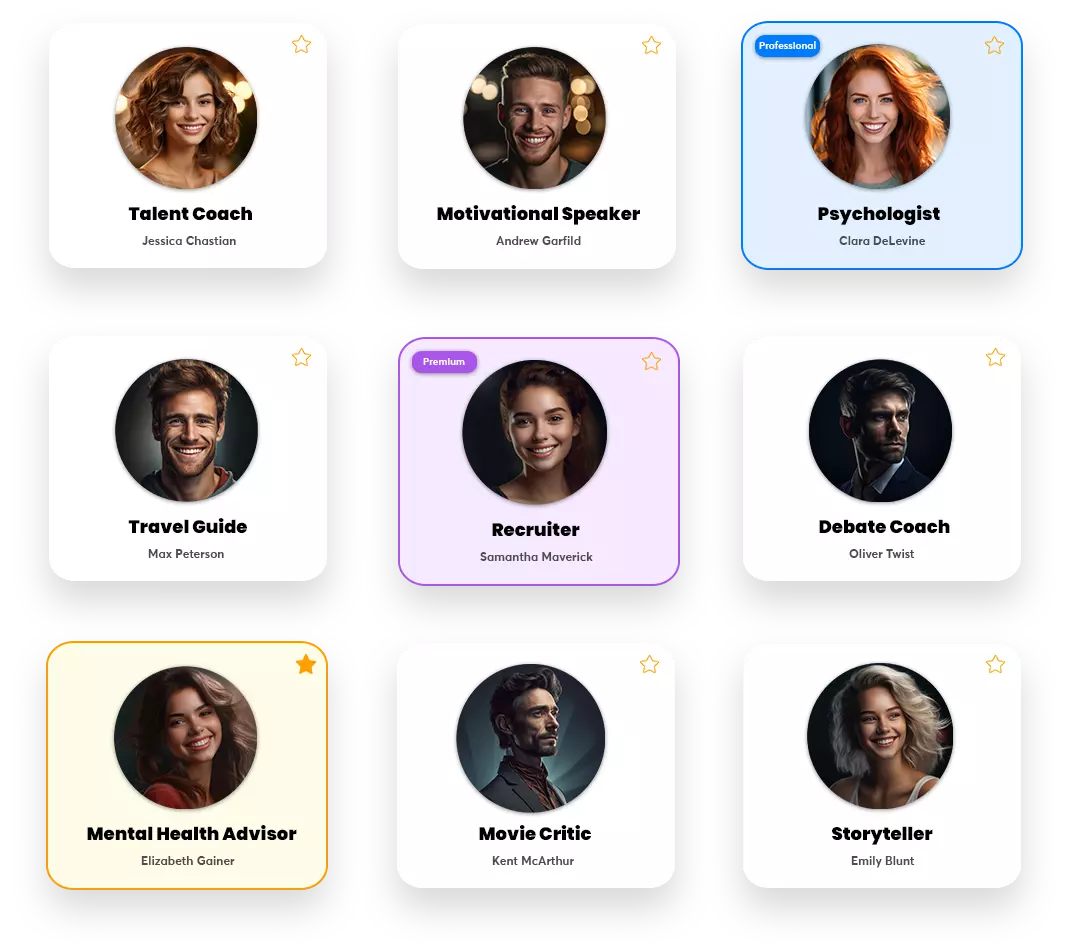
Generación de contenido de IA
Crea contenido increíble 10 veces más rápido
VanKast AI can help you with a variety of writing tasks, from writing blog post, creating better resumes and job descriptions to composing emails and social media content, and many more. With 70+ templates, we can save you time and improve your writing skills.
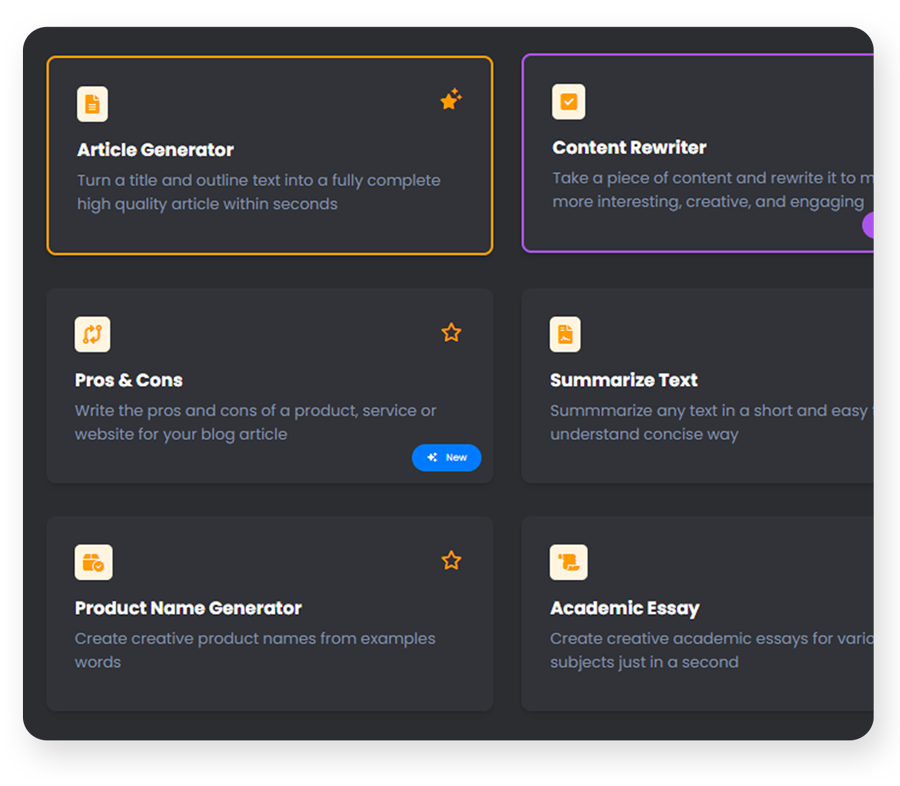
Creación de imágenes de IA
Usa IA para crear cualquier arte o imagen
¿Buscas una herramienta que te ayude a crear obras de arte e imágenes únicas y hermosas de manera rápida y fácil? ¡No busques más! Nuestro software impulsado por IA hace que sea simple generar arte e imágenes de alta calidad con solo unos pocos clics. Con nuestra interfaz intuitiva y tecnología poderosa, puedes crear visuales impresionantes en minutos en lugar de horas.

Síntesis de locución de IA
Crea locuciones de calidad de estudio en minutos
Emociones verdaderamente humanas en cada locución generada, dando vida a tus locuciones. Nuestras voces de IA tienen elementos que hacen que una voz suene NATURAL y tienen todas las expresiones e inflexiones de tono necesarias para hacer que las personas se involucren más con tu contenido
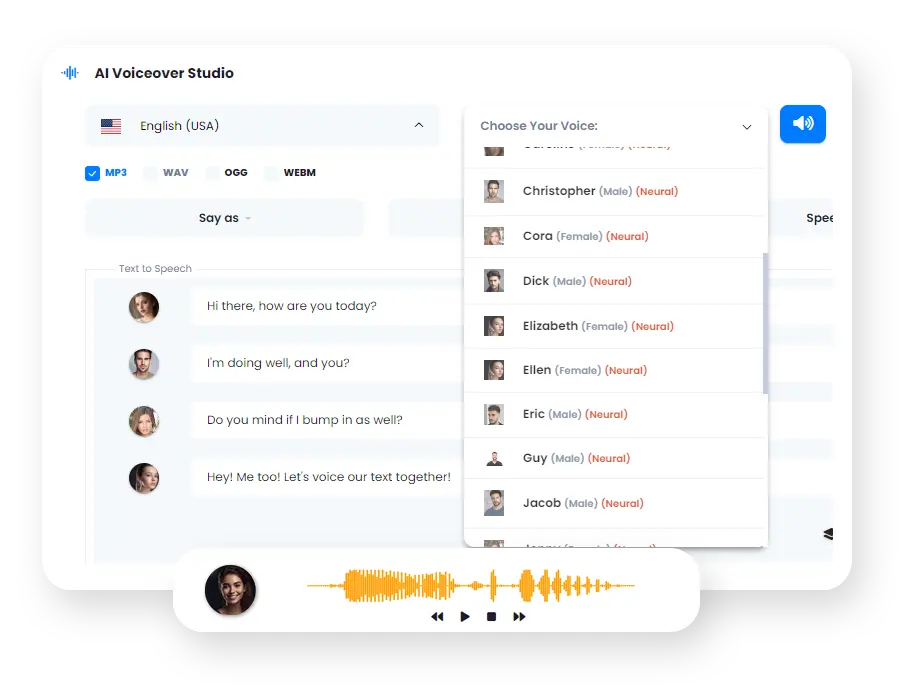
Transcripción de voz a texto de IA
Transcribe tu audio con precisión
Transcribe con precisión contenido de audio en varios formatos. Habilita la transcripción de tus archivos de audio en múltiples idiomas, así como la traducción de esos idiomas al inglés.
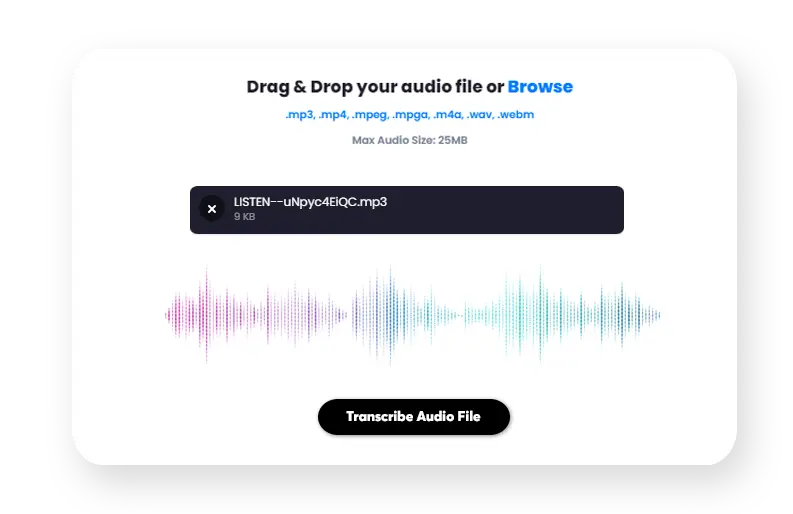
Generación de código de IA
Escribe código como profesional
Genera algoritmos complejos simplemente usando lenguaje natural para explicar lo que buscas, nosotros nos encargaremos del resto. Escribe código como profesional en Python, Flutter, PHP, JavaScript, Ruby y otros lenguajes de programación.
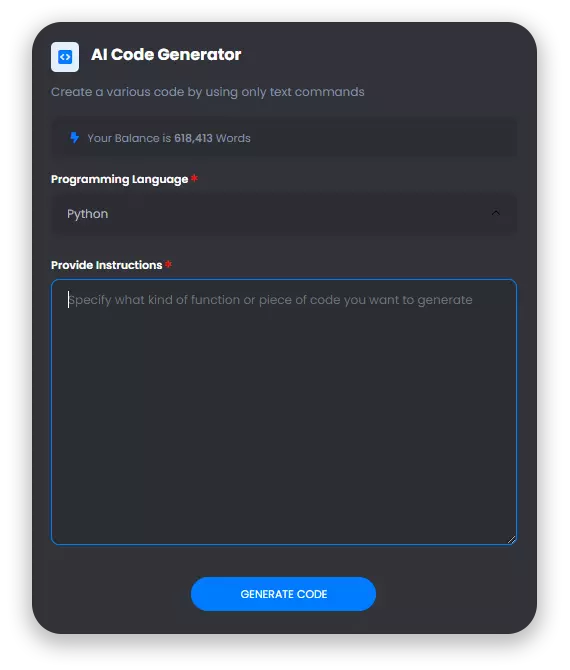
Lista de funciones
Only platform that you will ever need
Ads
Crea anuncios mucho más rápido y sé más creativo
Títulos de clickbait
Crea títulos de clickbait creativos para tus productos
Titulares de anuncios
Escribe titulares de anuncios que capten la atención
Publicaciones de blog
Contenido para generar artículos, publicaciones de blog
Títulos de blog
Nadie quiere leer títulos de blog aburridos, genera títulos de blog atractivos con esta herramienta
Sección de blog
Escribe una sección completa de blog (unos pocos párrafos) sobre un subtítulo de tu artículo
Ideas de blog
La herramienta perfecta para comenzar a escribir grandes artículos. Genera ideas creativas para tu próxima publicación
Blog Intros
Escribe una introducción que atraiga a tus visitantes a leer más sobre tu artículo
Conclusión de blog
Termina tus artículos de blog con un párrafo de conclusión atractivo
Contenidos
Herramientas para escribir creativos para diferentes estados de ánimo y tareas
Generador de artículos
Convierte un título y un esquema de texto en un artículo completo de alta calidad en segundos
Reescritor de contenido
Toma un fragmento de contenido y reescríbelo para hacerlo más interesante, creativo y atractivo
Generador de párrafos
Genera párrafos sobre cualquier tema incluyendo una palabra clave y en un tono de voz específico
Puntos de discusión
Escribe puntos cortos, simples e informativos para los subtítulos de tu artículo
Pros y contras
Escribe los pros y contras de un producto, servicio o sitio web para tu artículo de blog
Resumir texto
Resume cualquier texto de manera breve y fácil de entender
Descripción del producto
Escribe la descripción de tu producto y por qué vale la pena
Generador de nombres de startups
Genera nombres geniales, creativos y atractivos para tu startup en segundos
Generador de nombres de productos
Crea nombres de productos creativos a partir de palabras de ejemplo
Ensayo académico
Crea ensayos académicos creativos para diversas materias en solo un segundo
Historias creativas
Permite que la IA genere historias creativas para ti basadas en texto ingresado
Corrector gramatical
Asegúrate de que no haya errores en tu contenido
Resumir para un niño de 2do grado
Resume cualquier contenido complejo para un niño de 2do grado
Extensor de texto
Extiende tus oraciones con más descripción e información adicional
Reescribir con palabras clave
Reescribe tu contenido existente incluyendo palabras clave específicas
Ideas de negocio
Genera ideas de negocio basadas en tus palabras clave y descripción
Cambiador de tono
Cambia el tono de tu escritura para que coincida con tu audiencia
Diccionario
Usa un diccionario para encontrar todos los detalles de tu palabra
Política de privacidad
Desarrolla información de política de privacidad para tu organización
Términos y condiciones
Desarrolla información de términos y condiciones para tu organización
Ecommerce
Herramientas poderosas para comercio electrónico, listados de tus productos
Descripción de producto de Amazon
Crea descripciones de productos de Amazon que capten la atención
Beneficios del producto
Enumera los beneficios del producto con la ayuda de una solución de IA
Títulos de productos en venta
Descubre títulos de productos en venta para la descripción de tu producto
Comparaciones de productos
Crea una comparación completa de dos productos entre sí
Características del producto
Escribe las características completas del producto
Características del producto de Amazon
Ventajas y características de tus productos que los harán irresistibles para los compradores
Correos electrónicos
Plantillas creativas para la creación de correos electrónicos
Correo de bienvenida
Crea correos de bienvenida para tus clientes
Correo frío
Crea correos fríos profesionales con la ayuda de IA
Correo de seguimiento
Crea seguimientos de correo profesionales con solo unos clics
Líneas de asunto de correo electrónico
Crea líneas de asunto de correo electrónico profesionales
Marcos
Las mejores herramientas de redacción publicitaria de marketing
Marco de Problema-Agitación-Solución (PAS)
Genera una de las fórmulas de redacción publicitaria más efectivas para tu negocio
Marco de Atención-Interés-Deseo-Acción (AIDA)
El modelo AIDA te ayudará a asegurar que cualquier tipo de escritura sea lo más efectivo posible
Marco de Antes-Después-Puente (BAB)
Fórmula orientada a la conversión diseñada para hacer que una oferta particular sea más atractiva
Marco de Promesa-Imagen-Prueba-Empuje (PPPP)
Usa la fórmula 4P para crear contenido persuasivo que motive a los lectores a actuar
Marketing
Herramientas profesionales de relaciones públicas para marca y negocio
Comunicado de prensa de la empresa
Escribe un comunicado de prensa de la empresa con la ayuda de IA
Comunicado de prensa de marca/producto
Escribe un comunicado de prensa de marca o producto con la ayuda de IA
Nombres de marca
Genera nombres de marca únicos con la ayuda de IA
Redes sociales
Herramientas rápidas para contenido de redes sociales
Anuncios de Facebook
Escribe anuncios de Facebook que involucren a tu audiencia y ofrezcan una alta tasa de conversión
Subtítulos de Instagram
Capta la atención con subtítulos atractivos para tus publicaciones de Instagram
Generador de hashtags de Instagram
Encuentra los mejores hashtags para usar en tus publicaciones de Instagram
Publicación en redes sociales (Personal)
Escribe una publicación en redes sociales para ti mismo para ser publicada en cualquier plataforma
Publicación en redes sociales (Negocios)
Escribe una publicación para tu negocio para ser publicada en cualquier plataforma de redes sociales
Titulares de Facebook
Escribe titulares atractivos y convincentes para destacar tus anuncios de Facebook
Titulares de Google Ads
Escribe titulares atractivos de 30 caracteres para promocionar tu producto con Google Ads
Descripción de Google Ads
Escribe una descripción de Google Ads que haga destacar tu anuncio y genere clientes potenciales
Publicaciones de LinkedIn
Crea una publicación interesante de LinkedIn con la ayuda de IA
Tweets de Twitter
Genera tweets interesantes de Twitter con IA
Titulares de anuncios de LinkedIn
Titulares de anuncios para LinkedIn que captan la atención, inducen clics y tienen alta conversión
Descripciones de anuncios de LinkedIn
Descripciones de anuncios profesionales y llamativas que harán que tu producto brille
Video
Herramientas de creación de videos desde la idea hasta el guion para millones de vistas
Descripciones de video
Escribe descripciones de YouTube atractivas para interesar a las personas en tu video
Títulos de video
Escribe un título de video de YouTube atractivo para captar la atención de todos
Generador de etiquetas de YouTube
Genera etiquetas / palabras clave optimizadas para SEO para tu video de YouTube
Guiones de video
Crea rápidamente guiones para tus videos y comienza a grabar
TikTok Video Scripts
Guiones de video listos para grabar que te harán viral
Sitios web
Contenidos útiles para sitios web
Descripción meta
Escribe una descripción meta optimizada para SEO basada en una descripción
Preguntas frecuentes
Genera preguntas frecuentes basadas en la descripción de tu producto
Respuestas de FAQ
Genera respuestas creativas a preguntas (FAQ) sobre tu negocio o sitio web
Testimonios / Reseñas
Agrega prueba social a tu sitio web generando testimonios de usuarios
Biografía de la empresa
Escribe una biografía completa de la empresa basada en tus entradas
Generador de boletines
Genera un boletín basado en la información proporcionada
Otro
Resto de las herramientas de usuario que puedes usar
Letras de canciones
Genera letras de canciones basadas en tu descripción y palabras clave
Notificaciones de aplicaciones y SMS
Mensajes de notificación para tus aplicaciones, sitios web y dispositivos móviles que captan la atención de los usuarios
Títulos de clickbait
Crea títulos de clickbait creativos para tus productos
Titulares de anuncios
Escribe titulares de anuncios que capten la atención
Títulos de blog
Nadie quiere leer títulos de blog aburridos, genera títulos de blog atractivos con esta herramienta
Sección de blog
Escribe una sección completa de blog (unos pocos párrafos) sobre un subtítulo de tu artículo
Ideas de blog
La herramienta perfecta para comenzar a escribir grandes artículos. Genera ideas creativas para tu próxima publicación
Blog Intros
Escribe una introducción que atraiga a tus visitantes a leer más sobre tu artículo
Conclusión de blog
Termina tus artículos de blog con un párrafo de conclusión atractivo
Generador de artículos
Convierte un título y un esquema de texto en un artículo completo de alta calidad en segundos
Reescritor de contenido
Toma un fragmento de contenido y reescríbelo para hacerlo más interesante, creativo y atractivo
Generador de párrafos
Genera párrafos sobre cualquier tema incluyendo una palabra clave y en un tono de voz específico
Puntos de discusión
Escribe puntos cortos, simples e informativos para los subtítulos de tu artículo
Pros y contras
Escribe los pros y contras de un producto, servicio o sitio web para tu artículo de blog
Resumir texto
Resume cualquier texto de manera breve y fácil de entender
Descripción del producto
Escribe la descripción de tu producto y por qué vale la pena
Generador de nombres de startups
Genera nombres geniales, creativos y atractivos para tu startup en segundos
Generador de nombres de productos
Crea nombres de productos creativos a partir de palabras de ejemplo
Ensayo académico
Crea ensayos académicos creativos para diversas materias en solo un segundo
Historias creativas
Permite que la IA genere historias creativas para ti basadas en texto ingresado
Corrector gramatical
Asegúrate de que no haya errores en tu contenido
Resumir para un niño de 2do grado
Resume cualquier contenido complejo para un niño de 2do grado
Extensor de texto
Extiende tus oraciones con más descripción e información adicional
Reescribir con palabras clave
Reescribe tu contenido existente incluyendo palabras clave específicas
Ideas de negocio
Genera ideas de negocio basadas en tus palabras clave y descripción
Cambiador de tono
Cambia el tono de tu escritura para que coincida con tu audiencia
Diccionario
Usa un diccionario para encontrar todos los detalles de tu palabra
Política de privacidad
Desarrolla información de política de privacidad para tu organización
Términos y condiciones
Desarrolla información de términos y condiciones para tu organización
Descripción de producto de Amazon
Crea descripciones de productos de Amazon que capten la atención
Beneficios del producto
Enumera los beneficios del producto con la ayuda de una solución de IA
Títulos de productos en venta
Descubre títulos de productos en venta para la descripción de tu producto
Comparaciones de productos
Crea una comparación completa de dos productos entre sí
Características del producto
Escribe las características completas del producto
Características del producto de Amazon
Ventajas y características de tus productos que los harán irresistibles para los compradores
Correo de bienvenida
Crea correos de bienvenida para tus clientes
Correo frío
Crea correos fríos profesionales con la ayuda de IA
Correo de seguimiento
Crea seguimientos de correo profesionales con solo unos clics
Líneas de asunto de correo electrónico
Crea líneas de asunto de correo electrónico profesionales
Marco de Problema-Agitación-Solución (PAS)
Genera una de las fórmulas de redacción publicitaria más efectivas para tu negocio
Marco de Atención-Interés-Deseo-Acción (AIDA)
El modelo AIDA te ayudará a asegurar que cualquier tipo de escritura sea lo más efectivo posible
Marco de Antes-Después-Puente (BAB)
Fórmula orientada a la conversión diseñada para hacer que una oferta particular sea más atractiva
Marco de Promesa-Imagen-Prueba-Empuje (PPPP)
Usa la fórmula 4P para crear contenido persuasivo que motive a los lectores a actuar
Comunicado de prensa de la empresa
Escribe un comunicado de prensa de la empresa con la ayuda de IA
Comunicado de prensa de marca/producto
Escribe un comunicado de prensa de marca o producto con la ayuda de IA
Nombres de marca
Genera nombres de marca únicos con la ayuda de IA
Letras de canciones
Genera letras de canciones basadas en tu descripción y palabras clave
Notificaciones de aplicaciones y SMS
Mensajes de notificación para tus aplicaciones, sitios web y dispositivos móviles que captan la atención de los usuarios
Descripciones de video
Escribe descripciones de YouTube atractivas para interesar a las personas en tu video
Títulos de video
Escribe un título de video de YouTube atractivo para captar la atención de todos
Generador de etiquetas de YouTube
Genera etiquetas / palabras clave optimizadas para SEO para tu video de YouTube
Guiones de video
Crea rápidamente guiones para tus videos y comienza a grabar
TikTok Video Scripts
Guiones de video listos para grabar que te harán viral
Descripción meta
Escribe una descripción meta optimizada para SEO basada en una descripción
Preguntas frecuentes
Genera preguntas frecuentes basadas en la descripción de tu producto
Respuestas de FAQ
Genera respuestas creativas a preguntas (FAQ) sobre tu negocio o sitio web
Testimonios / Reseñas
Agrega prueba social a tu sitio web generando testimonios de usuarios
Biografía de la empresa
Escribe una biografía completa de la empresa basada en tus entradas
Generador de boletines
Genera un boletín basado en la información proporcionada
Lista de funciones
Only platform that you will ever need
Te cubrimos en todos los aspectos de generación de texto y audio de IA para que solo te enfoques en la creación de contenido
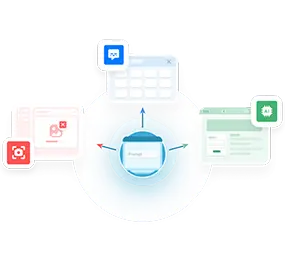
Personalizar plantillas
Crea y entrena tu plantilla personalizada única y disfruta

Variedad de idiomas
Genera contenido de IA en más de 54 idiomas y aumentando
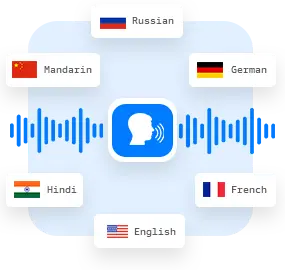
Más de 144 idiomas para locuciones de IA
Amplia variedad de idiomas y dialectos para locuciones de IA

Mezcla hasta 20 voces
Selecciona entre más de 540 voces neuronales de IA y mezcla en una sola tarea de síntesis de texto

SSML y tonos
Configura el flujo del discurso y texto con etiquetas SSML y tonos

Pagos convenientes
12 pasarelas de pago diferentes que puedes usar en cualquier momento

Gana con referidos
Trae a tus amigos y gana cuando se suscriban

Seguridad y soporte mejorados
Autenticación segura 2FA y soporte al cliente 24/7 para abordar cualquier inquietud
Testimonios y reseñas
Be one of our Happy Customers
Aún no se han publicado reseñas de clientes
Preguntas frecuentes
Got Questions? We have you covered
Siempre estamos aquí para brindar soporte completo y aclarar cualquier duda que puedas tener
- Narrow AI (Weak AI): AI systems designed for specific tasks.
- Generative AI: AI models that can generate new content (text, images, code, etc.).
- Large Language Models (LLMs): AI models trained on massive datasets of text.
Mantente actualizado





















































































Anuncios de Facebook
Escribe anuncios de Facebook que involucren a tu audiencia y ofrezcan una alta tasa de conversión
Subtítulos de Instagram
Capta la atención con subtítulos atractivos para tus publicaciones de Instagram
Generador de hashtags de Instagram
Encuentra los mejores hashtags para usar en tus publicaciones de Instagram
Publicación en redes sociales (Personal)
Escribe una publicación en redes sociales para ti mismo para ser publicada en cualquier plataforma
Publicación en redes sociales (Negocios)
Escribe una publicación para tu negocio para ser publicada en cualquier plataforma de redes sociales
Titulares de Facebook
Escribe titulares atractivos y convincentes para destacar tus anuncios de Facebook
Titulares de Google Ads
Escribe titulares atractivos de 30 caracteres para promocionar tu producto con Google Ads
Descripción de Google Ads
Escribe una descripción de Google Ads que haga destacar tu anuncio y genere clientes potenciales
Publicaciones de LinkedIn
Crea una publicación interesante de LinkedIn con la ayuda de IA
Tweets de Twitter
Genera tweets interesantes de Twitter con IA
Titulares de anuncios de LinkedIn
Titulares de anuncios para LinkedIn que captan la atención, inducen clics y tienen alta conversión
Descripciones de anuncios de LinkedIn
Descripciones de anuncios profesionales y llamativas que harán que tu producto brille